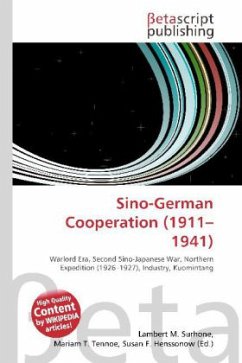
Sino-German Cooperation (1911 - 1941 )
Versandkostenfrei!
Versandfertig in 6-10 Tagen
32,99 €
inkl. MwSt.

PAYBACK Punkte
16 °P sammeln!
Please note that the content of this book primarily consists of articles available from Wikipedia or other free sources online. Between 1911 and 1941, cooperation between Germany and China was instrumental in modernizing the industry and the armed forces of the Republic of China prior to the Second Sino-Japanese War. The Republic of China, which succeeded the Qing Dynasty in 1912, was fraught with factional warlordism and foreign incursions. The Northern Expedition of 1928 nominally unified China under Kuomintang (KMT) control, yet Imperial Japan loomed as the greatest foreign threat. The Chin...
Please note that the content of this book primarily consists of articles available from Wikipedia or other free sources online. Between 1911 and 1941, cooperation between Germany and China was instrumental in modernizing the industry and the armed forces of the Republic of China prior to the Second Sino-Japanese War. The Republic of China, which succeeded the Qing Dynasty in 1912, was fraught with factional warlordism and foreign incursions. The Northern Expedition of 1928 nominally unified China under Kuomintang (KMT) control, yet Imperial Japan loomed as the greatest foreign threat. The Chinese urgency to modernize the military and its national defense industry, coupled with Germany''s need for a stable supply of raw materials, put the two countries on the road of close relations from the late 1920s to the late 1930s. Although intense cooperation lasted only from the Nazi takeover of Germany in 1933 to the start of the war with Japan in 1937, and concrete measures at industrialreform started in earnest only in 1936, it had a profound effect on Chinese modernization and the capability of the Chinese to resist the Japanese in the war.












